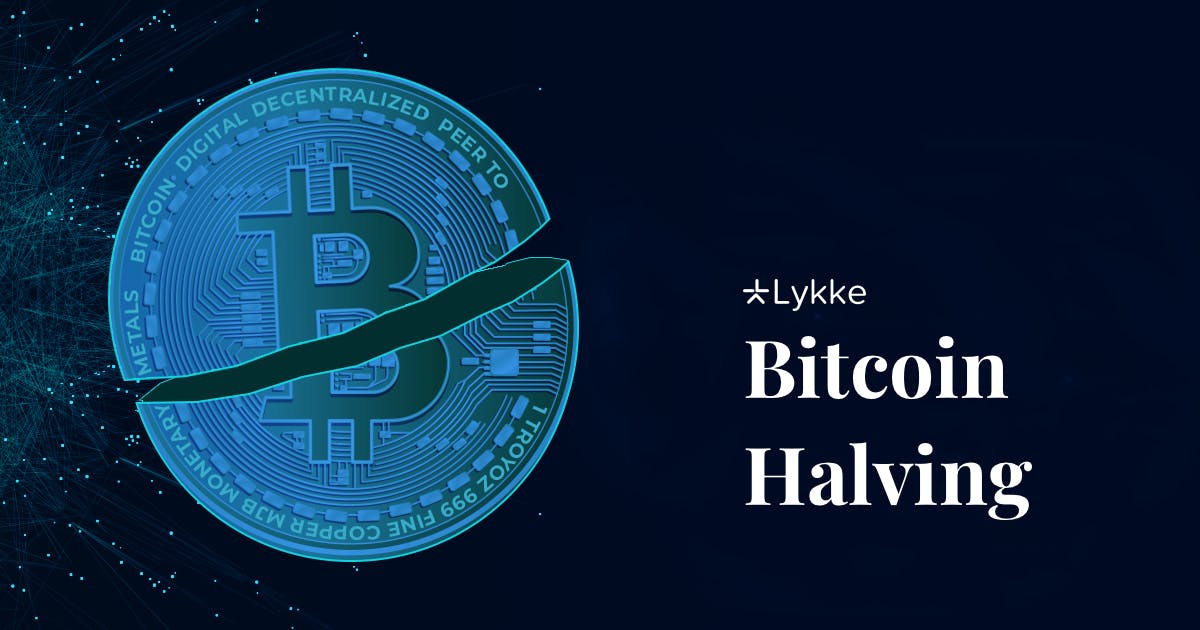What is the Bitcoin halving?

- Date
- 14/10/2021
- Written by
- Lykke
- Share
- Leave your opinion (0 reviews)
If you are a crypto enthusiast or even take a passing interest in the cryptocurrency industry then you would have heard of the latest upcoming Bitcoin halving, unless you have been living under a rock in recent times. There is no doubt that it is one of the most anticipated events of the crypto calendar in 2020. But what exactly is it?
The Bitcoin halving is a recurring event whereby the number of Bitcoins (BTC) awarded to miners is cut by half.
Where fiat currencies such as the Euro are issued by central banks, there is no central body 'issuing' Bitcoin. Instead, it’s coded into the Bitcoin protocol that new Bitcoin is 'issued' as a reward to miners for validating a ‘block’.
A block on the Bitcoin blockchain is a file which stores 1MB worth of Bitcoin transaction records. In the case of Bitcoin, blocks are added to the blockchain through a consensus mechanism called proof of work (PoW). In PoW, miners compete to add the next block in the chain by using resource heavy hardware to solve a complex mathematical problem. This produces a hash – a seemingly-random 64 character output.
Once the hash is located, the block is closed and cannot be changed. After successfully mining a block, miners are rewarded with newly-created Bitcoins. This process occurs approximately every 10 minutes.
When Bitcoin was first released back in 2009, the reward was 50 BTC per block, which by today's standards is one large reward, however halvings are programmed in to take place every 210,000 blocks that have been mined, which takes roughly four years with diminishing returns for the reward amount.
In 2012, it was reduced to 25 BTC per block. Then in 2016, it was reduced to 12.5 BTC per block. This year’s halving will see the block rewards fall from 12.5 to 6.25 Bitcoin. The fourth halving is expected in 2024 when the rewards will fall to 3.125 new BTC, and on it goes for every subsequent four year period.
But why do we actually have to do a Bitcoin halving?
Bitcoin’s supply is limited to 21 million units by its in-built algorithm. No more than that amount can ever exist ever! No way to game the system here I’m afraid.
Bitcoin operates on a deflation model. This means that, bit by bit, less and less Bitcoins will be released over time until then the supply stops completely. There are currently around 18 million BTC in circulation, which is approximately 85% of the total cap. The very last Bitcoin should be mined around the year 2140.
This is very different to fiat currencies, which use an inflationary model. Inflation is a model where a central bank can print extra currency at will – think quantitative easing which was brought in the global banking crisis, this is a practice that is often criticised and has historically led to some major economic problems. Nobody can randomly inflate Bitcoin’s supply even if they wanted to.
Limiting supply has also proved a good way to drive adoption. It has incentivised prospective adopters & forward thinking investors to buy Bitcoin before it runs out.
At heart the halving is a mechanism programmed into Bitcoin code that is designed to prevent inflation. It is designed to prevent miners mining all the Bitcoin too quickly and thereby throwing the supply-demand equation out of kilter.
When shall I mark the date?
A halving is pre-programmed to take place after every 210,000 blocks that have been mined which takes approximately four years. Once it has reached block 630000 which at the time of writing is expected to happen on May the 12th 2020 with the current rate of producing blocks. Read more about the next Bitcoin halving looming in April 2024.
Will Bitcoin’s price go up or down?
In the past, the halving has meant an increase in the price. The first halving took place on 28 November 2012, when one BTC was worth only $11. In the course of just a year after the event, Bitcoin’s price rose right up to $1,100. The second halving took place in July 2016. Bitcoin maintained a price of around $600–$700 before shooting right up to $20,000 at the end of 2017
The cryptocurrency space is very different now though and much more mature, with the impact of the halving much more difficult to predict. With many institutional investors and products such as Bitcoin futures meaning that the cut to supply is a lot more likely to be priced in than previously thought. There are also other cryptocurrencies such as Bitcoin Cash and XRP to take into account, offering a lot more competition for investors compared to previous halvings.
If you look at crypto twitter there are certainly two camps whereby half think the price will go to the moon and the other half think that the price will dump. There are certainly arguments for both, the issue is that the current economic climate is in a very precarious position with the ongoing global pandemic. Regardless of what camp you sit in though this is a hugely exciting time to be part of the new financial system and watching from the sidelines.